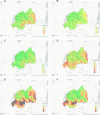Geostatistical modeling of malaria prevalence among under-five children in Rwanda
- PMID: 33596876
- PMCID: PMC7890836
- DOI: 10.1186/s12889-021-10305-x
Geostatistical modeling of malaria prevalence among under-five children in Rwanda
Abstract
Background: Malaria has continued to be a life-threatening disease among under-five children in sub-Saharan Africa. Recent data indicate rising cases in Rwanda after some years of decline. We aimed at estimating the spatial variations in malaria prevalence at a continuous spatial scale and to quantify locations where the prevalence exceeds the thresholds of 5% and 10% across the country. We also consider the effects of some socioeconomic and climate variables.
Methods: Using data from the 2014-2015 Rwanda Demographic and Health Survey, a geostatistical modeling technique based on stochastic partial differential equation approach was used to analyze the geospatial prevalence of malaria among under-five children in Rwanda. Bayesian inference was based on integrated nested Laplace approximation.
Results: The results demonstrate the uneven spatial variation of malaria prevalence with some districts including Kayonza and Kirehe from Eastern province; Huye and Nyanza from Southern province; and Nyamasheke and Rusizi from Western province having higher chances of recording prevalence exceeding 5%. Malaria prevalence was found to increase with rising temperature but decreases with increasing volume for rainfall. The findings also revealed a significant association between malaria and demographic factors including place of residence, mother's educational level, and child's age and sex.
Conclusions: Potential intervention programs that focus on individuals living in rural areas, lowest wealth quintile, and the locations with high risks should be reinforced. Variations in climatic factors particularly temperature and rainfall should be taken into account when formulating malaria intervention programs in Rwanda.
Keywords: Demographic and health survey; Exceedance probability; Geostatistical modeling; Malaria prevalence; Rwanda.
Conflict of interest statement
The authors declare that they have no competing interests.
Figures



Similar articles
-
Spatio-temporal dynamics of malaria in Rwanda between 2012 and 2022: a demography-specific analysis.Infect Dis Poverty. 2024 Sep 16;13(1):67. doi: 10.1186/s40249-024-01237-w. Infect Dis Poverty. 2024. PMID: 39278924 Free PMC article.
-
Modeling the shared risks of malaria and anemia in Rwanda.PLoS One. 2024 Apr 22;19(4):e0298259. doi: 10.1371/journal.pone.0298259. eCollection 2024. PLoS One. 2024. PMID: 38648210 Free PMC article.
-
Spatio-Temporal Bayesian Models for Malaria Risk Using Survey and Health Facility Routine Data in Rwanda.Int J Environ Res Public Health. 2023 Feb 28;20(5):4283. doi: 10.3390/ijerph20054283. Int J Environ Res Public Health. 2023. PMID: 36901291 Free PMC article.
-
Bayesian geostatistical modelling of stunting in Rwanda: risk factors and spatially explicit residual stunting burden.BMC Public Health. 2022 Jan 24;22(1):159. doi: 10.1186/s12889-022-12552-y. BMC Public Health. 2022. PMID: 35073893 Free PMC article.
-
Effects of vector-control interventions on changes in risk of malaria parasitaemia in sub-Saharan Africa: a spatial and temporal analysis.Lancet Glob Health. 2014 Oct;2(10):e601-15. doi: 10.1016/S2214-109X(14)70300-6. Lancet Glob Health. 2014. PMID: 25304636
Cited by
-
Spatio-temporal dynamics of malaria in Rwanda between 2012 and 2022: a demography-specific analysis.Infect Dis Poverty. 2024 Sep 16;13(1):67. doi: 10.1186/s40249-024-01237-w. Infect Dis Poverty. 2024. PMID: 39278924 Free PMC article.
-
Modeling the shared risks of malaria and anemia in Rwanda.PLoS One. 2024 Apr 22;19(4):e0298259. doi: 10.1371/journal.pone.0298259. eCollection 2024. PLoS One. 2024. PMID: 38648210 Free PMC article.
-
Comparison of new computational methods for spatial modelling of malaria.Malar J. 2023 Nov 21;22(1):356. doi: 10.1186/s12936-023-04760-7. Malar J. 2023. PMID: 37990242 Free PMC article.
-
Climate variability, socio-economic conditions and vulnerability to malaria infections in Mozambique 2016-2018: a spatial temporal analysis.Front Public Health. 2023 Jun 1;11:1162535. doi: 10.3389/fpubh.2023.1162535. eCollection 2023. Front Public Health. 2023. PMID: 37325319 Free PMC article.
-
Spatio-Temporal Bayesian Models for Malaria Risk Using Survey and Health Facility Routine Data in Rwanda.Int J Environ Res Public Health. 2023 Feb 28;20(5):4283. doi: 10.3390/ijerph20054283. Int J Environ Res Public Health. 2023. PMID: 36901291 Free PMC article.
References
-
- Centers for Disease Control and Prevention. Malar key facts. 2011.
-
- WHO . World malaria report 2019. Geneva: World Health Organization; 2019.
Publication types
MeSH terms
LinkOut - more resources
Full Text Sources
Other Literature Sources
Medical

